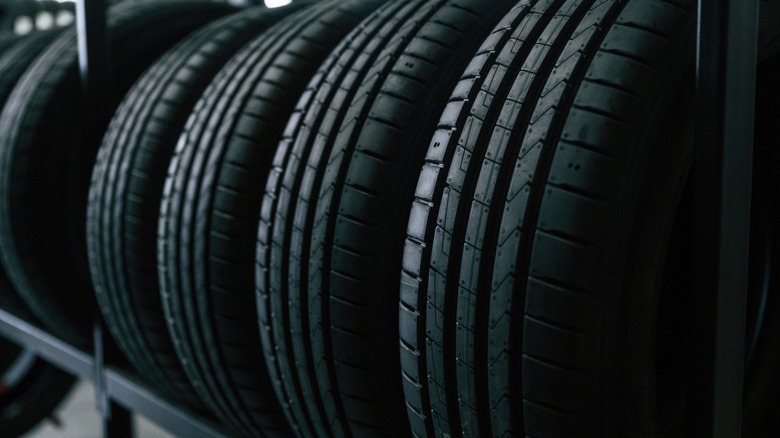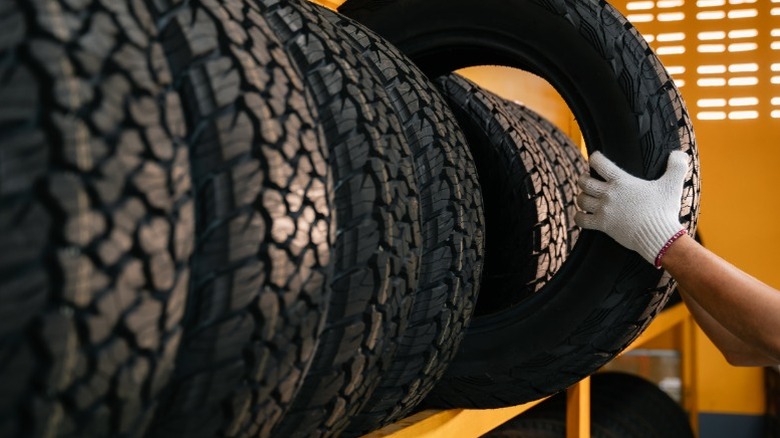Can You Have Two Different Brands' Tires On Your Car?
If you're like many car owners, you probably don't anticipate buying new tires with much excitement. When it comes to routine auto maintenance, purchasing a new set of tires for your car is one of the more expensive items on the list. On average, just one new tire can cost anywhere from around $80 to well over $250, meaning even a set of four new tires from the cheapest brand is still a formidable expense.
Luckily, new tires usually last for between three and five years before they wear out and need to be replaced. Tires, especially quality ones, are engineered to stand up against some of the harshest conditions imaginable. However, despite that durability, there's no guarantee that all four of your tires will have the same luck when it comes to avoiding injury and damage. If you do end up with one busted tire, you may wonder if you have to replace it with the same brand as the others on your car. It's a good question, especially if you need to buy tires within the next year or so, and you don't want to spend the cash for only one tire right now.
The general answer is yes, you can use two different brands' tires on your car. However, there is some nuance to that statement — just because you can use different tire brands, it doesn't mean you can slap any tire you want on your vehicle. It still needs to meet your car's specifications, and, depending on your vehicle's drive type, it'll need to meet a few other conditions, too. If you're wondering what those conditions are, stick around. Here's everything you need to know about using different brands' tires on your car.
Using different brands' tires is fine if they're the same size
While we've established that it is technically okay to use two different brands' tires on your car, there are some caveats. First of all, it's vital that you use tires that fit your vehicle, as recommended by your car's manufacturer. You can find information about your tires' size in your vehicle owner's manual, by checking the placard in the driver-side door jamb, or by reaching out to a professional. It's important that you use the proper size tires, not only because your car is designed for a specific size of tire, but also because using tires of various sizes at the same time can be disastrous for your vehicle's drivetrain and handling. There are some vehicles that use different size tires on the front and rear axles. However, you should never use different size tires on the same axle.
The tire's size isn't the only factor to consider when installing different brands' tires on your car. It's also important to factor in tread depth/direction, tire application, and your vehicle's drive type. Tread depth is critical to consider because if you install a brand-new tire on the left side of your car while the other side has nearly bald tires, it will create an imbalance.
When installing one new tire, you should put the tires with the best tread together (i.e., on the same and, ideally, the rear axle) and the tires with the worst tread together. Finally, it's also vital that you take your car's drive type into consideration. If your vehicle is all-wheel-drive or four-wheel-drive, you should not replace one tire at a time, regardless of the brand, as doing so can lead to severe drivetrain damage.
How to choose the right tire brand for you
Even though it's technically okay to use different brands' tires on your car, the best practice is to purchase four new tires at the same time. That also means you probably won't be mixing and matching different brands. However, it does mean that it's a good idea to do some research to figure out which tire manufacturer is right for you and your vehicle. A lot of people may stress over buying tires, especially when trying to decide between cheap and expensive tires and which is best.
Luckily, buying new tires for your car doesn't have to be overly complicated. According to most experts, instead of buying the cheapest or the most expensive tire available, most average drivers should opt for a mid-range product. That's because the cheapest tires are often built with low-quality or outdated materials. They may provide shorter expected lifespans, which leads to buying new tires more frequently, and they may be unable to offer the same level of stability and traction as more expensive brands. On the other hand, some of the most expensive tires are designed for niche driving scenarios, like drag racing or off-road activities. If you're not into these types of driving, you don't need to pay extra for specialized rubber.
That said, there's nothing wrong with buying expensive tires, as long as they meet your car's specifications, that is. Brands like Continental Tires, Michelin, and Goodyear are commonly considered to be some of the best on the market. However, it's worth noting that many of these brands also offer cheaper subsidiaries, which provide similar quality at lower prices. Comparing several brands, their life expectancies, and warranties can go a long way toward getting the right tires at the right price.


